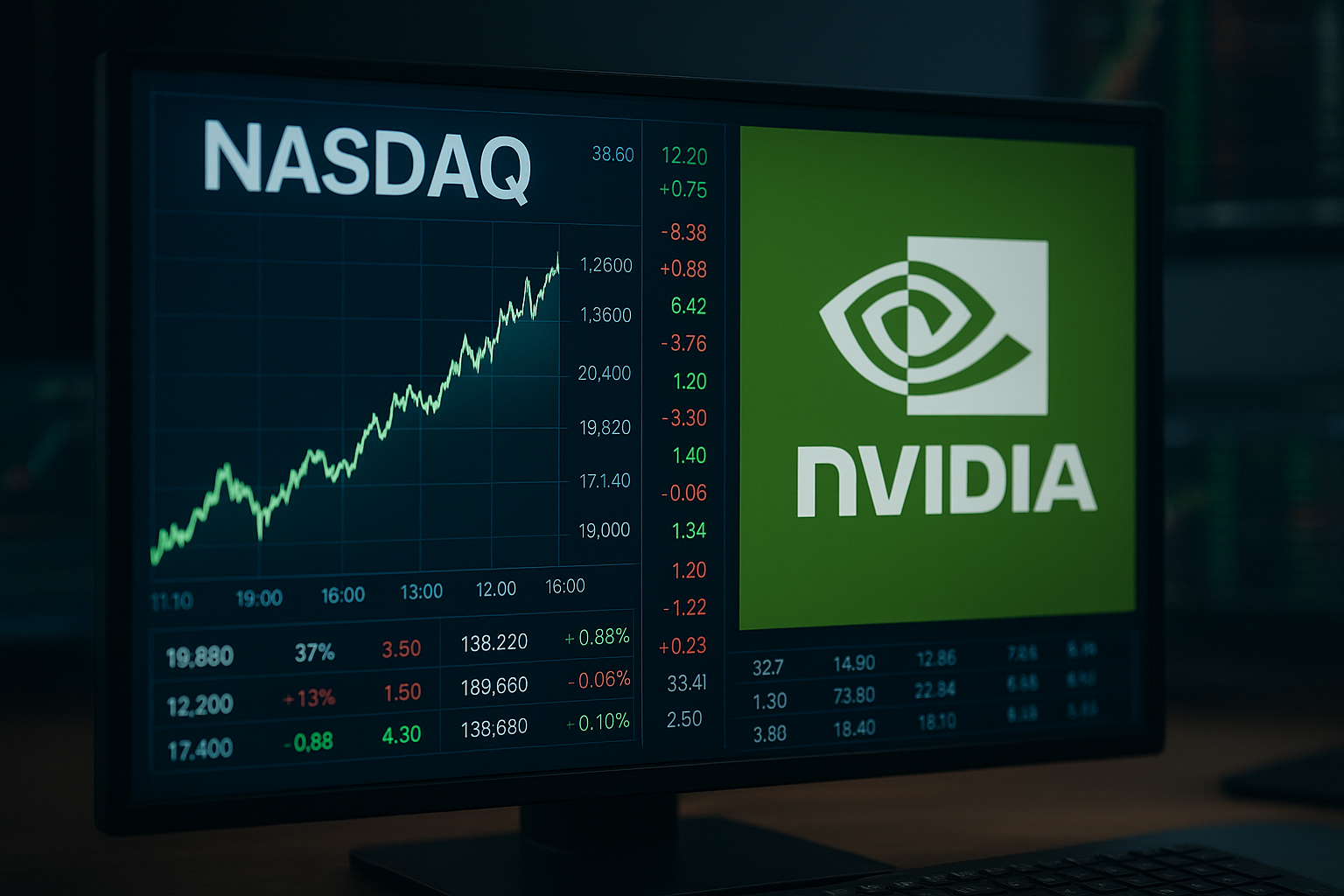Wall Street woke up bullish on Tuesday, with S&P 500 and Nasdaq futures inching higher as Nvidia Corporation ($NVDA) surged nearly 3% in pre-market trading — pushing its market capitalization within striking distance of an unprecedented US $5 trillion. The move came after the chipmaker disclosed US $500 billion in AI-chip bookings and announced plans to build seven new government-funded supercomputers, further cementing its dominance in the artificial intelligence hardware ecosystem.
As traders brace for a wave of major tech earnings — including Apple, Amazon, and Alphabet — optimism in AI remains the engine of market momentum. Meanwhile, the Federal Reserve is widely expected to cut interest rates in its upcoming meeting, fueling expectations of a soft landing for the U.S. economy.
The AI-Driven Rally Gains Fresh Fuel
Nvidia’s explosive valuation run has been one of the defining narratives of 2025. What began as a semiconductor story has evolved into a full-blown AI infrastructure boom — one that now underpins global equity performance. The company’s $500 billion backlog reflects institutional demand not just from the private sector but also government-led initiatives to secure domestic AI computing capacity.
According to Reuters, Nvidia’s new projects involve partnerships with U.S. federal agencies to deploy AI-driven data centers and research supercomputers — a move that aligns with Washington’s broader technological competitiveness agenda. Analysts at JPMorgan and Goldman Sachs have raised their 12-month price targets for Nvidia by 10–15%, citing “structural demand for compute power” and “multi-year visibility on order growth.”
This momentum has spilled into the broader market. The Nasdaq Composite is up 29% year-to-date, and the S&P 500’s tech-heavy weighting continues to pull indices higher. AI-linked ETFs — including the Global X Robotics & AI ETF (BOTZ) and ARK Next Generation Internet ETF (ARKW) — have outperformed the benchmark index by wide margins, underscoring investor appetite for the sector.
Why This Matters for Investors
The question now is whether the rally can sustain itself — or whether markets are nearing “peak optimism.” Nvidia’s near-$5 trillion valuation would make it worth more than the entire FTSE 100 index combined, a level that raises questions about concentration risk.
Morgan Stanley’s Mike Wilson recently warned that “AI valuations may be decoupling from earnings reality,” though he acknowledged the sector’s long-term potential. Still, the dominance of a few mega-cap tech names — Nvidia, Apple ($AAPL), Microsoft ($MSFT), Amazon ($AMZN), and Alphabet ($GOOGL) — now accounts for more than 35% of the S&P 500’s total market cap, the highest concentration in over two decades.
That concentration cuts both ways. A strong earnings season could ignite another leg higher in equities, but any disappointment — whether in Nvidia’s guidance or broader AI adoption rates — could trigger a swift market correction.
The Fed Factor: Easing Into Risk
The other major variable this week is the Federal Reserve’s rate decision. Markets are pricing in a 25 basis-point cut, reflecting easing inflation and softening labor-market data. A dovish signal could further extend risk appetite, particularly for growth stocks sensitive to lower discount rates.
However, Bloomberg Economics cautions that “a too-early rate cut may revive inflationary pressures in high-growth sectors such as technology and housing.” For investors, this creates a nuanced environment: the Fed’s easing could sustain market optimism in the short term — but also inflate asset bubbles in speculative corners of the tech trade.
Future Trends to Watch
- AI Supply Chain Expansion: Demand for GPUs and high-bandwidth memory chips could benefit not only Nvidia but also suppliers like TSMC ($TSM), SK Hynix, and Micron ($MU).
- Earnings Season Impact: Tech-heavy portfolios will be most exposed to volatility over the next two weeks as mega-caps report.
- Valuation Compression Risks: With forward P/E ratios on major AI leaders now exceeding 40x, any slowdown in data-center growth could reprice expectations sharply.
- Policy and Regulation: Growing concerns over AI regulation, export controls, and energy usage could become key market variables into 2026.
Key Investment Insight
AI remains the defining growth narrative of this cycle — but not all AI plays are created equal. Investors should focus on companies with clear cash-flow visibility from AI infrastructure and enterprise adoption, rather than purely speculative models. Balancing exposure between AI hardware leaders (like Nvidia) and diversified enablers (such as TSMC and Broadcom) could offer better long-term risk-adjusted returns.
For those seeking safer positioning, tech-dividend ETFs or broad-market indices with reduced AI concentration may provide stability if the current euphoria fades.
The U.S. stock market’s rally continues to hinge on the strength of the AI boom — and for now, Nvidia remains its nucleus. But as valuations stretch and monetary policy pivots, disciplined allocation and realism will be the investor’s best allies.
Stay tuned with MoneyNews.Today for daily market intelligence that turns breaking news into actionable investment insight.





